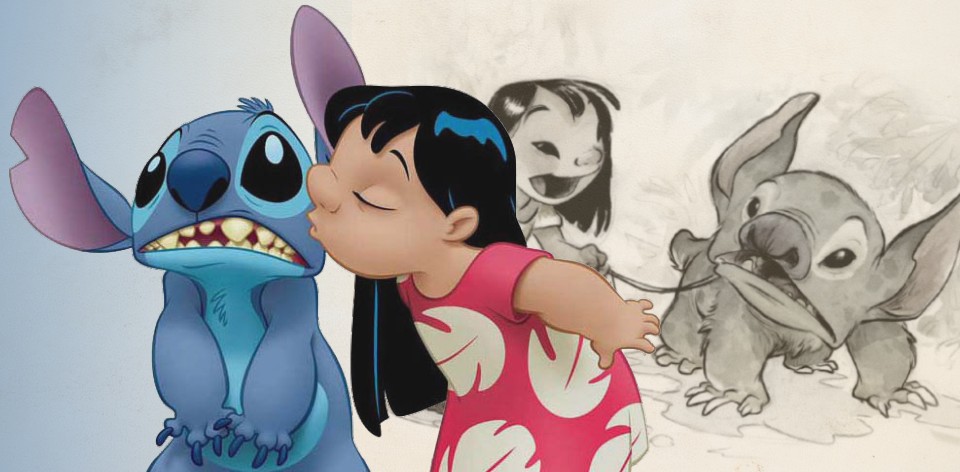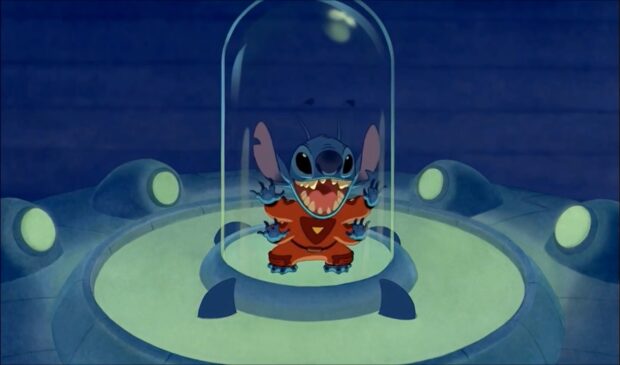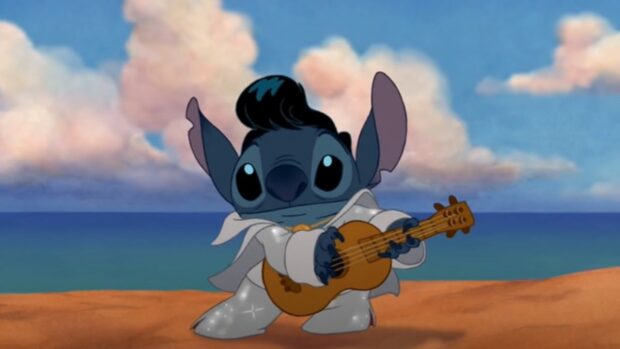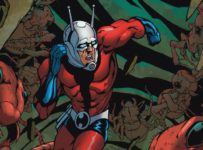“Lilo and Stitch? What’s a Lilo? And what the heck is a Stitch.” The way Roy E. Disney tells it, these were the first questions he had when he first heard about the pitch from Thomas Schumacher, the then-president of Walt Disney Feature Animation.
If we cast our minds back 20 years, Disney was a very different entity. While Pixar was going from strength to strength, the House of Mouse’s place as animation kings had been rattled. Following a string of commercially or critically disappointing results from Dinosaur, The Emperor’s New Groove and Atlantis: The Lost Empire, they also faced stiff competition from the likes of DreamWorks’ Shrek.
So, an unassuming film about a fractured family and a rambunctious alien — one that deals with social workers, childhood depression and social anxiety — was about as unlikely a hit as any. Leading to three non-theatrical sequels, a short film, three animated television series, multiple video games and theme park attractions, and endless merchandise, it was Disney’s first blockbuster of the 21st century.
Experiment 626: secret origins
If LILO & STITCH is a merchandising empire today, it certainly didn’t start that way. In fact, it was then-Disney CEO Michael Eisner’s attempt at doing something smaller, kind of in the vein of Dumbo, in the wake of several large-scale flops.
Developed as early as 1985 by co-director Chris Sanders as a children’s book concept, the low-profile approach gave him and the rest of the creative team a lot of creative leeway. “We would pay for our story freedom by controlling our budget,” Sanders told Polygon. Yet like all budgetary constraints, it was a necessity that birthed invention. It would also mean that young audiences saw things they may never have seen in animation before. Giving voice to kids who always saw themselves as ‘weird,’ it explored emotions with a nuance rarely afforded to youth fare.
Dean DeBlois stepped up from co-story lead on Mulan, where he first met Sanders, to co-writer and co-director. Together they wove something a little bit magic, shifting from Sanders’ original Kansas setting to Hawaii. As hard as it is to believe, Hawaii had never been used as a setting for an animated film before. It also gave them the concept of ‘ohana‘ (or family) that became so essential to the film’s emotional core.
From the start, LILO & STITCH distinguishes itself as something unique in the Disney animated canon. In the wonderful tome Lilo & Stitch: Collected Stories From the Film’s Creators, Sanders is cited as saying that it is a “story that begins where Disney films usually end.” Stitch is introduced a villain in captivity, an alien ‘abomination’ created as Experiment 626 by mad scientist Dr. Jumba Jookiba’s (voiced by David Ogden Stiers). When 626 escapes, he crash-lands on Earth and his fate is altered.
As Jumba and incompetent minder Pleakley (Kevin McDonald) search for 626, the lonely and troubled Lilo (Daveigh Chase) and her older sister/legal guardian Nani (Tia Carrera) first encounter him in an animal shelter. Thinking he is a dog, she names him Stitch and takes him home. Both Lilo and Stitch have trouble socialising, to the point that social worker Cobra Bubbles (Ving Rhames) threatens to take Lilo away from Nani. Despite the constant danger of re-capture, the duo find a way to help each other come to terms with their respective grief.
“I remember everyone that leaves”
Which is where LILO & STITCH really sets itself apart from so many other Disney films of the era. The result of flying under the radar allowed Sanders and DeBlois to quietly craft a character-driven drama in the guise of a sci-fi adventure. Much like Steven Spielberg’s E.T.: The Extra-Terrestrial, this single parent household has created some tangible drama. “We’re a broken family, aren’t we?” ask Lilo. “No,” responds Nani, adding “Maybe, a little”
Unlike Elliot and Gertie in E.T., Nani and Lilo are not the products of divorce. While they rarely talk about the past, it is suggested that their parents have died in a car accident. When we first encounter Lilo, she has evidently been ‘acting out’ for a while. Seen as ‘weird’ by her classmates, she’s prone to angry outbursts, bites her bully, constructs elaborate backstories for her grotesque doll, and believes her fish Pudge controls the weather. Obsessed with Elvis Presley, Lilo is known for flopping on the floor next to her record player. “Leave me alone to die,” she declares while listening to Heartbreak Hotel. It’s heavy stuff even by adult standards.
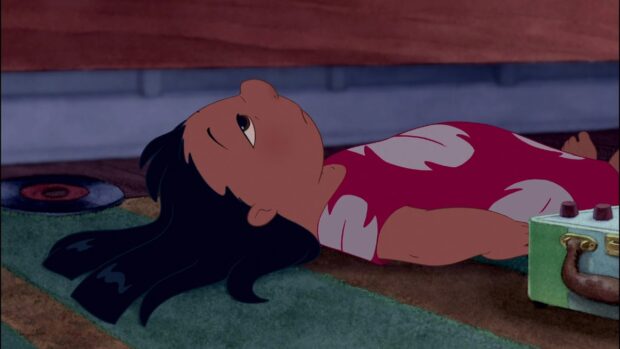
If Lilo shows all the classic signs of childhood depression, Stitch’s parallel introduction also has clear signs that he is reacting to trauma. Here is a living creature who isn’t even named at birth, effectively abandoned by his people immediately and exiled in a faraway land. Stitch is only violent and ‘naughty’ because he doesn’t know anything else.
Through the loose analogy to The Ugly Duckling story, Sanders and DeBlois acknowledge the idea of abandonment and genuine trauma, but they never dismiss them or try to fix them. This wonderful interpretation of ohana — which in native Hawaiian culture refers to one’s social support system, including everything from one’s nuclear family to extended relations, friends and colleagues — actively encourages young viewers to seek out their own support networks. It allows the characters to recognise that they might be ‘broken’ from one point of view, but that’s ok. A series of ups and downs shows that recovery isn’t always linear either, and fixing everything is not always the goal. To paraphrase Stitch, you can be “little and broken, but still good.”
“Aren’t they beautiful?”
LILO AND STITCH didn’t just challenge what animated films could talk about, but how they looked as well. As Pixar and DreamWorks leaned heavily into the now-standard CG animation, Sanders and DeBlois very consciously chose watercolour backgrounds to reflect the unique colours and textures of Hawaii.
Sanders has a particular way of designing his characters. Weight is distributed downwards, as if each bit of line art is a bag of sand ready to drift to the bottom if you picked Lilo up by her hair. Sanders loves soft curves. In fact, it’s another quirk of Lilo’s to take photos of rotund individuals on the beach and cherish them as art. There is always a flow to the way weight shifts in his characters, continuing to create the illusion of life when characters are momentarily still.
It fits in perfectly with the rhythm and flow of island life. From the title sequence, backed by Mark Kealiʻi Hoʻomalu and the Kamehameha Schools Children’s Chorus, Polynesian culture is very much part of the film’s DNA. While not as overtly inclusive as 2016’s Moana, Sanders and DeBlois infuse every cel with carefully chosen fabrics, plants and people. The deceptively simple surfing scene is joyful, but is effective because it brings all these elements together in a single setting.
Also cute and fluffy!
LILO AND STITCH is currently slated for a live-action remake, which might just be emblematic of how different Disney is from the company that made this ‘little’ picture in 2002. It is a film that was very much influenced by the history of animation while tapping into an intangible zeitgeist to deliver something new and fresh. Twenty years later, it still feels contemporary.
Inadvertently launching a treasure trove of merchandise, you can find him on everything from t-shirts to acrylic nails. In Asia, Stitch found even greater success, with targeted animated series were made for Japan and China. Indeed, Stitch featured in one of the launch attractions at Hong Kong Disneyland, and took over another Disney icon — The Enchanted Tiki Room: Stitch Presents Aloha e Komo Mai! — in the Tokyo park.
This is probably why the multiple sequels and series have never quite been able to capture the raw magic of the original. It’s no longer the little film that could, existing now as part of the bigger Disney cinematic universe. Yet it is filled with so much heart and beauty, it’s a love letter that speaks directly to those of us who never felt we quite fit in. Who suffered through loss but came out the other side. It’s ours. We found it, all on our own. It’s bigger, and far from broken, but still good. Yeah, still good.

